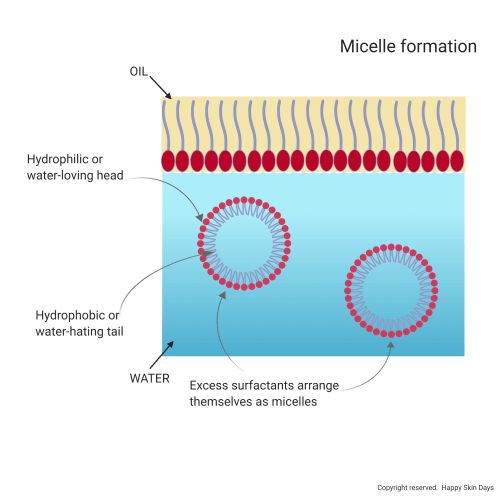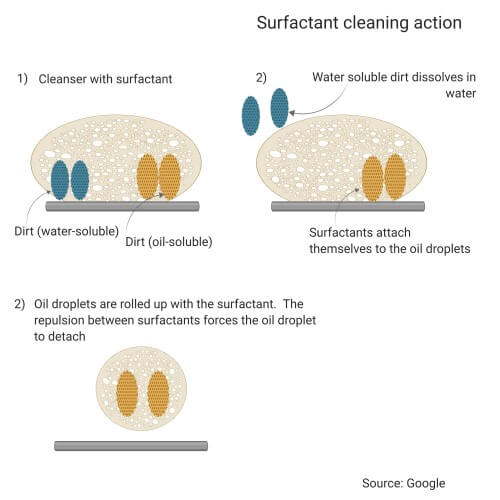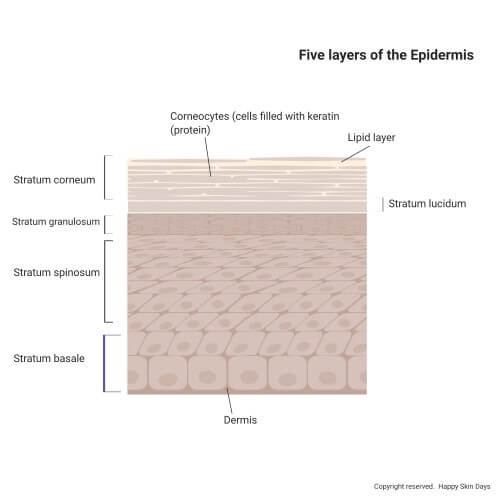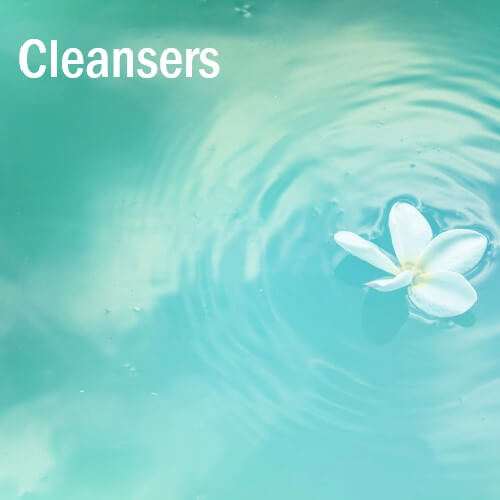Over the next few weeks, I’ll be road-testing as many cleansers as I can.
Water only removes water-soluble gunk on your face, but cleansers remove sebum, pollutants and make-up. Cleansers are essential to a normal functioning skin barrier. But using a harsh cleanser, on average twice a day, 7 days a week, can seriously damage your skin barrier…You need the right cleanser for your skin.
Before I recommend or ask you to ditch a particular cleanser, I feel that I should have used it and be able to give you a solid, geeky reason for doing so…This blog is therefore a basic 101 guide on how cleansers work. If this is already too much geekiness for you, look away now.
Introducing surfactants
Cleansers ranging from Life industrial detergents to facial cleansers all, rely on the same technology: surfactants.
A surfactant is, “chemical compound including in its molecule at least one group with an affinity for markedly polar* surfaces, ensuring in most cases its dissolution in water, and a non-polar group which has little affinity for water.”

When a sufficient number of surfactant molecules come into contact with water they form arrangements called micelles

Surfactants initially adhere to the surface of the water (called adsorption) and this reduces the surface tension between the two mediums, which are water and oil here. The micelles formed help increase the solubility of “fatty” type material (e.g.) sebum, make-up etc, making it easier for them to be rolled-up with the surfactant and washed away.
This is what washing looks like…
Using a facial cleanser, essentially involves the surfactant micelles adhering to the oil/liquid interface, rolling-up the oil, which is then washed away with water…

How do cleansers (surfactants) interact with the skin?
Now is as a good time as any to elaborate on the skin…
The skin is made of 3 layers, the epidermis, dermis and the hypodermis. The Epidermis is made of 5 layers:

The skin barrier and its functions
The Stratum Corneum (SC) (the topmost layer) comprises of flattened keratin rich corneocytes (or cells without a nucleus that are rich in protein) that are embedded in a lamellar lipid matrix. The lipid matrix contains mainly ceramides, cholesterol and free fatty acids.
Functions of the skin barrier
The SC is the body’s first barrier from the external environment and performs most of the skin barrier’s function. The two components of the stratum corneum, the extracellular lipid matrix and corneocytes (protein structure) perform different functions:
– The protein structure provides mechanical reinforcement to the skin, protects the skin from UVR damage, acts as an immunological barrier and maintains hydration. The protein structure itself holds water.
– The lipid matrix is the permeability barrier and therefore allows for (e.g.) nutrients to pass through; it excludes toxins and most importantly, it is a waterproof barrier that prevents Transepidermal water loss (TEWL). Other barrier functions of the skin include regulating temperature and maintaining the skin’s pH at about 4
Surfactant interaction with the skin barrier
The skin barrier is vulnerable on two fronts: the surfactants damage both the lipids in the skin as well as protein. The surfactant micelles have an affinity for oil and therefore it can take away not only excess sebum but also lipids in the lipid matrix. Stronly alkaline surfactants can denature protein, thereby making the SC more permeable and surfactants can go through the layers of the skin.

An impaired barrier is characterised by:
1) After-wash tightness
Cleansing will cause hyper-hyrdation immediately after washing followed by rapid evaporation of water to lower equilibrium levels of water in the skin, leading to after wash tightness. The skin proteins have a reduced ability to bind and hold water and so the skin is drier after washing. Also, there is a reduction in the Natural Moisturing Factors and the skin’s viscoelasticity, manifesting as AWT.
2) Skin dryness, scaling and roughness
In addition, lipids are damaged causing cholesterol and fatty acids to be removed from SC – even after one wash. This causes dry skin and the SC is more vulnerable to chapping/cracking and therefore barrier breakdown. With barrier breakdown comes TEWL (transepidermal water loss)..
3) Skin irritation, redness and itching.
These are all inflammatory responses to surfactants, and the thing is the surfactant does not even need to go deep into the skin.
What does a good cleanser look like?
This is my working hypothesis:

That’s it from me on cleansers…for now
Sources: Walters RM et al, Cleansing Formulations that Respect Skin Barrier Integrity, Dermatology Research and Practice, Vol 2012
K. P. Ananthapadmanabhan, David J. Moore et al, Cleansing without comprise: the impact of cleansers on the skin barrier and the technology of mild cleansing, 2004, Journal of Dermatologic Therapy, Vol 17, Issue 1, 16-25
https://www.clinimed.co.uk/wound-care/wound-essentials/structure-and-function-of-the-skin
https://www.karger.com/Article/Abstract/489527
S. Ghosh and D. Blankschtein, “The role of sodium dodecyl sulfate (SDS) micelles in inducing skin barrier perturbation in the presence of glycerol,” Journal of Cosmetic Science, vol. 58, no. 2, pp. 109–133, 2007.
Loden, M. Role of topical emollients and moisturizers in the treatment of dry skin barrier disorders. Am. J. Clin. Dermatol. 2003, 4, 771–788.
Biochim Biophys Acta. 2014 Mar;1841(3):280-94. doi: 10.1016/j.bbalip.2013.11.007. Epub 2013 Nov 18.
The Art and Science of Dermal Formulation Development by Marc B. Brown, Adrian C. Williams, Morgan B. Murphrey; Julia H. Miao; Patrick M. Zito, Histology, Stratum Corneum, reasure Island (FL): StatPearls Publishing; 2019 Jan-.
Okasaka M, Kubota K, Evaluation of anionic surfactants effects on the skin barrier function based on skin Permeability PHARMACEUTICAL DEVELOPMENT AND TECHNOLOGY, 2018 https://doi.org/10.1080/10837450.2018.1425885
